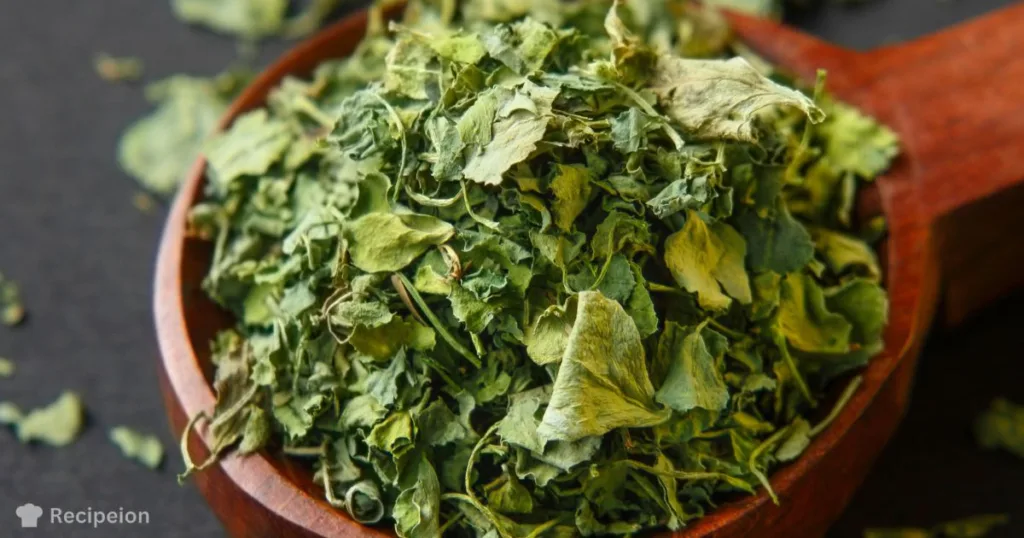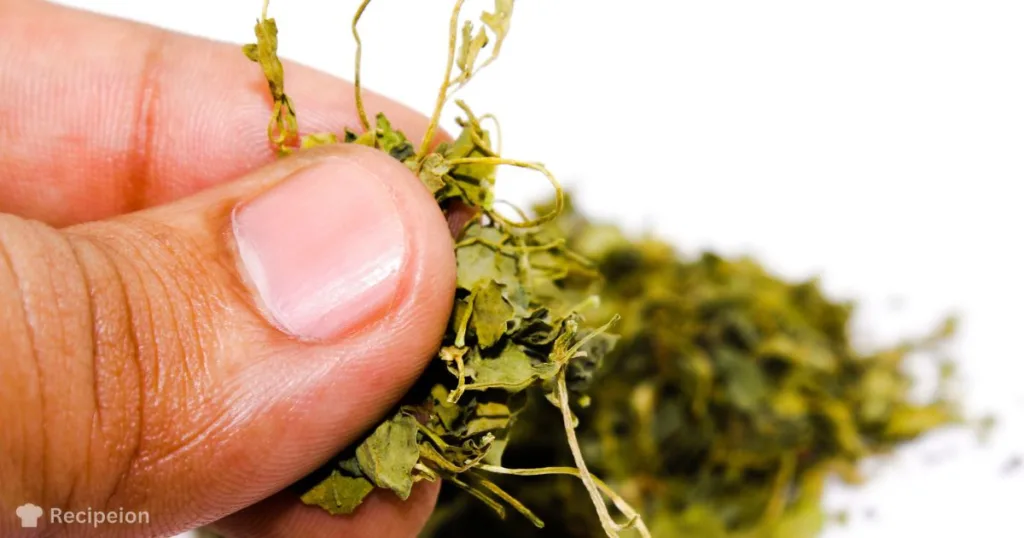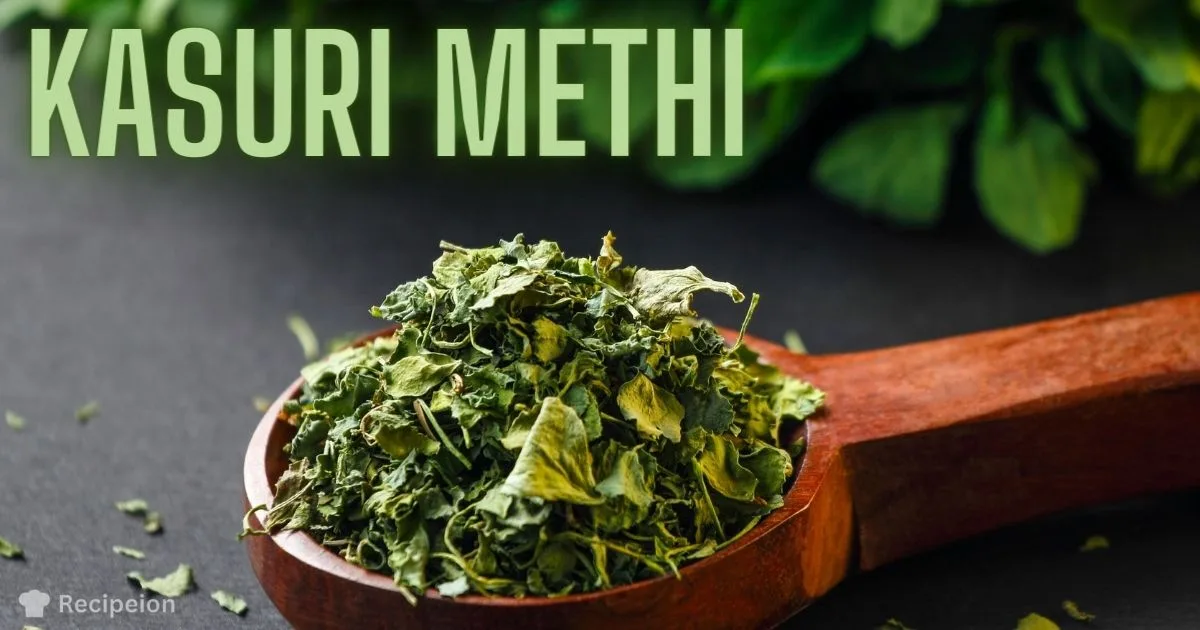Add a burst of fragrance and taste to your cooking using kasuri methi. Uncover its history, health advantages, and ways to make every meal exceptional.
WHAT IS KASURI METHI
Kasuri methi, also known as dried fenugreek leaves, is a versatile herb commonly used in Indian cooking. It originates from the fenugreek plant, scientifically known as Trigonella foenum-graecum. The leaves are harvested, dried, and crumbled, resulting in the aromatic kasuri methi we know today.

ORIGIN AND CULTIVATION
Fenugreek has been a staple in Indian and Mediterranean cuisines for centuries. It’s believed to have originated in the Middle East and then spread to different parts of the world. In Indian households, fenugreek is often cultivated in kitchen gardens and is an integral part of Ayurvedic practices due to its medicinal properties.
A FLAVORFUL PROFILE
Kasoori methi boasts a strong, slightly bitter flavor with undertones of earthiness and a pleasant aroma. This herb has the power to transform a dish, adding depth and complexity to its taste. Its aroma is especially prominent when the leaves are toasted or crushed.
FENUGREEK LEAVES VS KASURI METHI
- Fresh Fenugreek Leaves: These have a milder flavor and are often used in cooking vegetables and curries.
- Dried Kasuri Methi: Offers a concentrated flavor and is used to season various dishes.
CULINARY USES OF KASURI METHI
- Enhancing curries and gravies: Ksuri methi is a key ingredient in many Indian curries and gravies. Its distinct flavor complements the rich and spicy nature of these dishes, offering a balanced taste that tantalizes the taste buds.
- Twisting bread and snacks: Indian bread, such as naan and paratha, often incorporates kasuri methi into the dough. This imparts a wonderful aroma and flavor to the bread. Additionally, it can be used to season snacks like samosas and pakoras, making them even more irresistible.
- Marinades and rice dishes: Marinades for meats and vegetables benefit greatly from the addition of kasuri methi. It not only enhances the flavor but also helps tenderize the ingredients. Moreover, rice dishes like pulao and biryani gain a fragrant boost from this herb.
Enhance your culinary journey with the magic of kasuri methi. Its captivating aroma and rich flavor will open up a world of possibilities in your kitchen.
TIPS FOR USING KASURI METHI
- Preparation: Gently roast it in a dry pan for a minute to enhance its aroma.
- Crushing: Crush the roasted leaves between your palms or using a mortar and pestle to release their flavors.
- Balancing Flavors: Use it in combination with other spices like cumin, coriander, and cardamom to create a balanced flavor profile.
- Timing: Add it towards the end of cooking to preserve its fragrance and taste.
HEALTH BENEFITS OF KASURI METHI
- Rich in nutrients: this herb is a nutritional powerhouse, packed with vitamins, minerals, and antioxidants. It contains vitamin A, vitamin C, iron, and dietary fiber, contributing to overall well-being.
- Aiding digestion: The compounds present in it are known to support digestion by soothing the stomach lining and promoting the secretion of digestive enzymes.
- Blood sugar regulation: Studies suggest that fenugreek, its main component may help regulate blood sugar levels. It’s particularly beneficial for individuals with diabetes.
HOW TO REAP HEALTH BENEFITS
- Infuse it in herbal teas.
- Incorporate into whole wheat dough for added fiber.
- Use in moderation to harness its advantages.
ADDING KASURI METHI TO YOUR DIET
Adding it to your diet is easy. It can be sprinkled over cooked dishes, incorporated into doughs, or used as a seasoning in marinades. Start with a small amount and adjust to your taste preferences.
HOW TO USE IT
- Sprinkle on curries, stews, and lentil dishes.
- Mix with dough for flavorful rotis and parathas.
- Enhance rice dishes and marinades.
- Fresh leaves for salads and sautéed vegetables.
TIPS FOR BUYING AND STORING
SELECTING QUALITY
- Look for leaves that are green with no signs of discoloration.
- Opt for brands known for their quality.

PROPER STORING
- Keep in an airtight container in a cool, dry place.
- Avoid exposure to sunlight to retain its flavor.
Also read: Delicious Lauki Kofta Recipe
FAQ ABOUT KASURI METHI
- Is kasuri methi the same as fenugreek seeds? No, kasuri methi refers to the dried leaves of the fenugreek plant, whereas fenugreek seeds are the small, golden-brown seeds from the same plant.
- Can kasuri methi be used in non-Indian cuisines? Absolutely! While it’s popular in Indian dishes, it can be an exciting addition to various international cuisines, adding a new layer of flavor.
- What’s the recommended amount of kasuri methi in dishes? A little goes a long way. Start with a teaspoon for a dish serving four and adjust according to taste.
- How long does kasuri methi retain its flavor? When stored properly, it can retain its flavor for up to six months.
- Can kasuri methi be used in fresh salads? While it’s more commonly used in cooked dishes, you can experiment with adding a small amount of crushed kasuri methi to give your salads a unique twist.
CONCLUSION
Incorporating kasuri methi into your cooking not only elevates the taste of your dishes but also adds a touch of tradition and health benefits. Experiment with this aromatic herb to create delightful and flavorful meals that will impress your family and guests.
Remember, a little kasuri methi goes a long way. Use it thoughtfully to enhance your culinary creations and enjoy the goodness it brings to your table.
